List of Authors
>>About this blog
Recent blog post
|
[wienerhorn]
December 17, 2018 14:00
 Kiyosu Bridge, a nationally designated important cultural property, is one of the reconstruction bridges after the Great Kanto Earthquake, and is famous as one of the beautiful bridges that span the Sumida River along with Eitai Bridge. Kiyosu Bridge, a nationally designated important cultural property, is one of the reconstruction bridges after the Great Kanto Earthquake, and is famous as one of the beautiful bridges that span the Sumida River along with Eitai Bridge.
Two types of construction are underway for Kiyosu Bridge until the fall of next year, and the bridge is covered with temporary scaffolds.
One is the renovation of aging landscape lighting. The lighting will be LEDs.
The other is the repainting work to prevent rust due to deterioration of the coating film on the iron part.
The beautiful Kiyosu Bridge will be kept for a while, but it is important to maintain it and make it last longer.
[May rain George]
December 16, 2018 14:00
If you stop by Nihonbashi Ningyocho, there is a coffee shop that you should definitely visit. That is "Coffee Daishoken" on the street two north of amazake Yokocho. The name of a restaurant that doesn't look like a coffee shop. Speaking of Daishoken, Tsukemen shops have become famous these days, but Ningyocho has a completely different system, but there is a headquarters of "Chinese cuisine Daishoken", which has a long history. is.
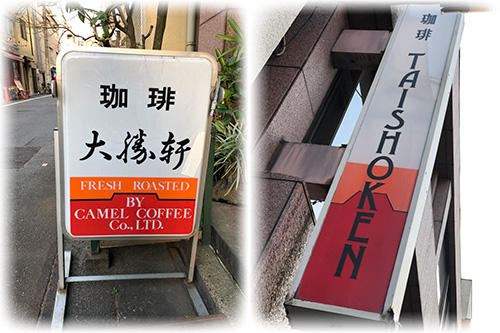
  
"Coffee Daishoken" often drops in after lunch with my colleagues from the company. This time, I decided to listen to the story again because there was too much uncertainty on the Internet, and the owner of the shop was confused.
We talked to the current owner, Yutaro Watanabe (5th generation of Daishoken) and his mother Chieko (4th generation).
  
 On the wall on the right side of the store, there is a book with the name of "Daishoken". I'm surprised because it is said that the hero of the Russo-Japanese War, General Nogi (Maresuke Nogi) was written. On the left of the book, there is a sign of "Tamewatabe-san" indicating that it is a gift to the first owner Watanabe, and indeed Maresuke Nogi. The name of the store "Daishoken" seems to have been named for its auspicious name in commemoration of its great victory in the Russo-Japanese War. It doesn't seem clear how it was, but General Nogi often seemed to come to play around Yanagibashi, and at that time he met for something. .. On the wall on the right side of the store, there is a book with the name of "Daishoken". I'm surprised because it is said that the hero of the Russo-Japanese War, General Nogi (Maresuke Nogi) was written. On the left of the book, there is a sign of "Tamewatabe-san" indicating that it is a gift to the first owner Watanabe, and indeed Maresuke Nogi. The name of the store "Daishoken" seems to have been named for its auspicious name in commemoration of its great victory in the Russo-Japanese War. It doesn't seem clear how it was, but General Nogi often seemed to come to play around Yanagibashi, and at that time he met for something. ..
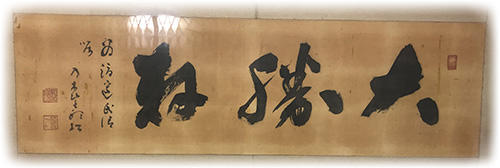
▲Name (Book: Maresuke Nogi)
  
 In the first place, "China's Cooking Daishoken" is Hannosuke Watanabe (born 1858!), the founder of Daishoken. However, it starts when I met Rin Ninken, a Chinese who was doing business at a stall. Mr. Hayashi was a young man who came to Japan from Guangdong at the age of 20 in 1905, and was doing business at stalls. At that time, Hannosuke, who was an oil wholesaler, decided to hire Mr. Hayashi as the chef to open a Chinese restaurant, probably because of the intuition of the merchant. However, Hannosuke died in the middle of his desire to open a business. Matsuzo, who had been adopted, changed his name to the second generation Hannosuke, took over the first will, and finally opened "China Miku Daishoken" in Naniwacho (currently Ningyocho) in 1913. I opened it. In the first place, "China's Cooking Daishoken" is Hannosuke Watanabe (born 1858!), the founder of Daishoken. However, it starts when I met Rin Ninken, a Chinese who was doing business at a stall. Mr. Hayashi was a young man who came to Japan from Guangdong at the age of 20 in 1905, and was doing business at stalls. At that time, Hannosuke, who was an oil wholesaler, decided to hire Mr. Hayashi as the chef to open a Chinese restaurant, probably because of the intuition of the merchant. However, Hannosuke died in the middle of his desire to open a business. Matsuzo, who had been adopted, changed his name to the second generation Hannosuke, took over the first will, and finally opened "China Miku Daishoken" in Naniwacho (currently Ningyocho) in 1913. I opened it.
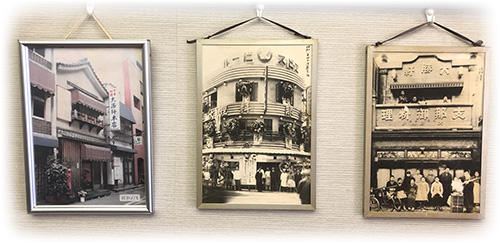
▲Left: 1986 Head Office, Middle: April 1933 Asakusa Branch, right: At the time of 1928
  
From the Taisho era to the Showa era, this neighborhood is full of vaudeville Suehiro, Meijiza, dance halls, cinemas, Suitengu, restaurants, etc., and Daishoken is also thriving. In the 1950s and 1950s, it expanded to three branches and 17 goodwill branches. Currently, four of them are active (Nihonbashi Honmachi store, Nihonbashi Yokoyama-cho store, Asakusabashi store, Shinkawa store).
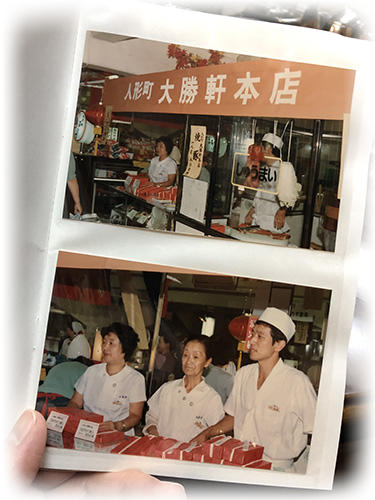
▲An event held in Mitsukoshi in the 1950s.
It seems that the order for food was delivered to Mitsukoshi from what was made at a shop in Ningyocho.
  
 Why is the main store Ningyocho store now becoming a coffee shop with a different business format? Why is the main store Ningyocho store now becoming a coffee shop with a different business format?
My mother (Chieko Watanabe) lost her husband early and became a widow in her thirties. I thought about closing the store when I decided to rebuild the store and house. It takes about a year and a half to build, and even if you find a temporary store, you will borrow it for a short period of time, what should your employees do. Due to various problems overlapping, after discussing with Yutaro, the fifth generation, he decided to work further.
Both the deceased husband and Yutaro love coffee. Two mothers and children went to a coffee classroom to study, and in 1988, changed their business to a coffee shop and opened. The name of the store will be left for the successive owners who have protected the main store, and for each store that has been allowed to distribute goodwill and has been operating until now, the name of "Daishoken" is left. It seems that he decided. Mom says. "I'm grateful to the people who have been taking over" Daishoken "for generations and the customers who have been involved in this coffee shop for 30 years in Heisei."
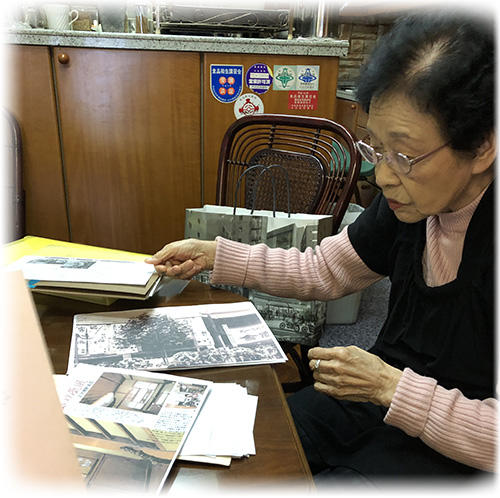
▲Mom (Chieko Watanabe)
I was able to listen to the story while showing valuable materials.
Well, the current "Coffee Daishoken". The customer service is in charge of a cheerful mother (Chieko), who is 90 years old. "I want to do my best until the Tokyo Olympics," he said. No, no, my mother is still strong and my teeth are all my own, so I don't think it's the Olympics, but I think the Osaka Expo is an Ochanoko Saisai!
  
 The history and name of the Chinese restaurant are all mentioned, but in fact, I would like to tell you more about this restaurant. That's because coffee is very delicious. The owner, Yutaro, will make a cup of coffee with a paper filter drip with heart after receiving the order. The history and name of the Chinese restaurant are all mentioned, but in fact, I would like to tell you more about this restaurant. That's because coffee is very delicious. The owner, Yutaro, will make a cup of coffee with a paper filter drip with heart after receiving the order.
The menu includes blends, Americans, 5 regular straight coffees (Kilimanjaro, Mandelin, Guatemala, Mokamatari, Colombia), and recommended beans (now Ethiopia). Other drinks such as milk, tea, cocoa, and juice.
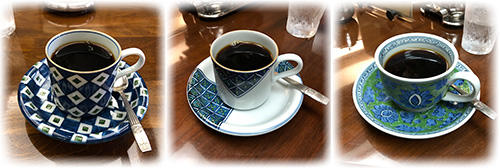
First of all, we recommend a blend of 400 yen. If you drink a blend, you can see the strength of the shop. The design of the coffee cup is also wonderful.
  
When it was opened, it was a rattan chair that was first prepared. This means that it has been used for 30 years. And it seems that they prepared tables etc. according to the chair.
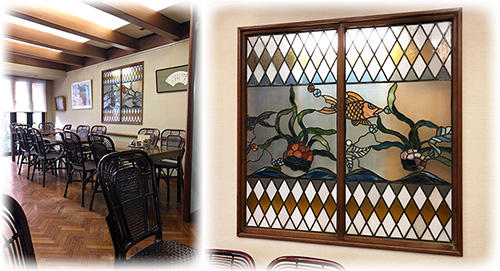
▲The rattan chair (left) from the coffee shop opened
Stained glass has been watching the restaurant since the days of Chinese restaurants.
  
You can also purchase "coffee tickets" at Daishoken (11 spells: 4000 yen). It's a very great ticket for me who likes coffee, so I always use it.
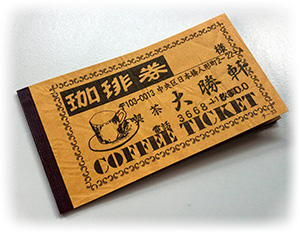 ▲Great coffee ticket ▲Great coffee ticket
  
When you come to Ningyocho, please drop in at "Coffee Daishoken". Why don't you refresh your mind with a cup of coffee? If you're lucky, you may be able to hear the story of this neighborhood and the history of Daishoken.
  
 This time, we talked about not only the story of the shop, but also the story of a celebrity who was regular during the Chinese restaurant era and the story of this neighborhood in the past, and became more and more interested in the history of Ningyocho. Was. And I became more like Ningyocho. This time, we talked about not only the story of the shop, but also the story of a celebrity who was regular during the Chinese restaurant era and the story of this neighborhood in the past, and became more and more interested in the history of Ningyocho. Was. And I became more like Ningyocho.
 Even so, where do the calm air in the store and this sense of comfort come from? Perhaps it is not only in the location of Ningyocho, but also in the life of Mr. Watanabe's mother and child who has carried the history of a famous Chinese restaurant called "Daishoken". It was this interview that made me feel like that. Even so, where do the calm air in the store and this sense of comfort come from? Perhaps it is not only in the location of Ningyocho, but also in the life of Mr. Watanabe's mother and child who has carried the history of a famous Chinese restaurant called "Daishoken". It was this interview that made me feel like that.
  
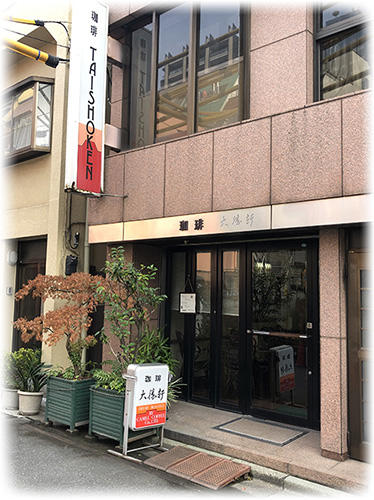
Coffee Daishoken
2-22-4, Nihonbashiningyocho, Chuo-ku, Tokyo
TEL: 03-3668-8600
Business hours 11:00~15:00
Regular holidays: Saturdays, Sundays and public holidays
[Nyan,]
December 9, 2018 18:00
The other day, when I took  a bus in Chuo-ku, I was near Ningyocho, saying, "Speaking of puppet ware around here, Shigemori, Itakuraya, and Kamei-do....I heard someone saying, "" a bus in Chuo-ku, I was near Ningyocho, saying, "Speaking of puppet ware around here, Shigemori, Itakuraya, and Kamei-do....I heard someone saying, ""
I said, "Oh, Kameido-san should have closed ... Kameido-san was selling "Saichosenbei (senbei)" which was written as "re-challenge", so I wonder if it was revived. "I thought I had to check secretly.
Now, we are constructing buildings and condominiums everywhere in the city center, such as Chuo-ku, and I don't think it's uncommon for us to say that the landscape has changed completely if we noticed.
As for the booklets such as "Nihonbashi on that day (Takeyodo)" that I have cut out some of the everyday scenery that should have been commonplace at that time, when I look now over time, I realize that they speak eloquently about the people's outfits and the hustle and bustle of the town, and I think, "A casual thing is fresh, exciting and valuable."
With that in mind, I went to amazake Yokocho in Ningyocho early in the morning as a fixed-point observation. (From Ningyocho, head toward Hamacho, where Meijiza is located.)
It seems that the place where there was a 100 yen shop before is being rebuilt. The enclosure of the construction site also serves as an advertisement/guidance version nearby.
(The shadow was beautifully reflected from the goodness of the camera's arm, please forgive  me.) me.)
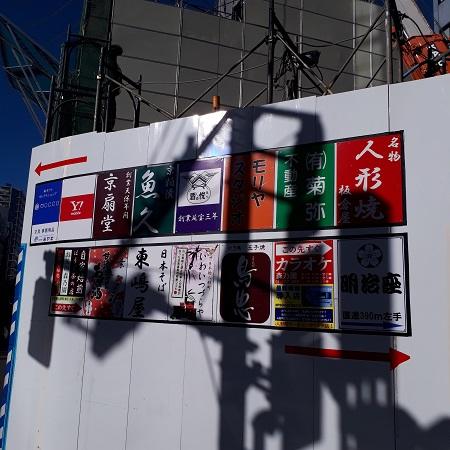
And here I noticed that the British cafe's Thai Reia Tearoom was moving to amazake Yokocho Street. You can enjoy delicious tea, scones, cakes, etc. at this shop, a cafe inspired by the British countryside. I also liked crotted cream, scones, black tea, chiffon cake, banana cake, etc. The shop was a little small, but it seems that it has been relocated and further expanded.
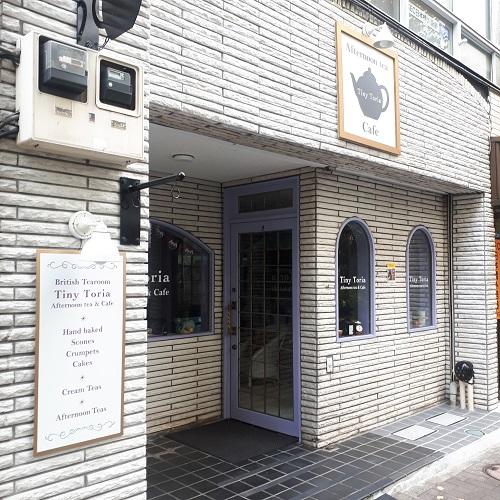
It was also called at the English fairs in Nihonbashi Mitsukoshi and Isetan, so "I thought it was delicious, but it was reasonable because I was called by Mitsukoshi" (/archive/2018/09/post-5598.html) (It was this shop that I got endorsed, not me, but I am a little happy  early in the morning). early in the morning).
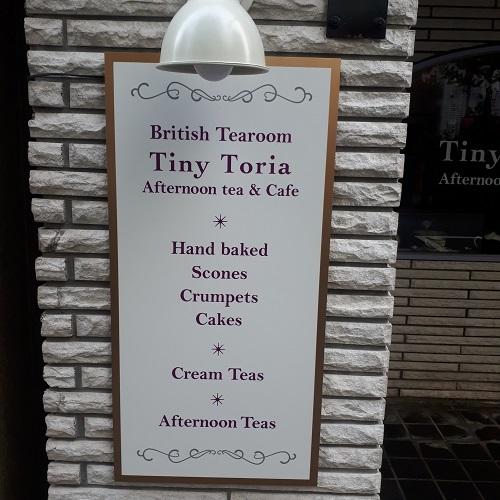
Unfortunately, Kameido, who was on the right side toward Meijiza, remained closed. (Speaking of puppet ware in Ningyocho, if there are some people who have not been updated, such as Nobudo Shigemori and Itakuraya, please refer to it.)
The last is a photo of the construction site of "Japan's No. 390m skyscraper (390m), which is scheduled to be completed in 2027, exceeding Abeno Harukas" at Nihonbashi Exit of Tokyo Station.
What will happen in 10 years or 15 years  ? The dress has changed completely, and what was this before? You might think that. ? The dress has changed completely, and what was this before? You might think that.
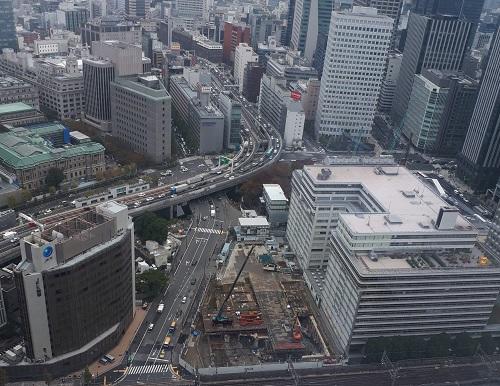 (Slightly expand construction sites only ↓) (Slightly expand construction sites only ↓)
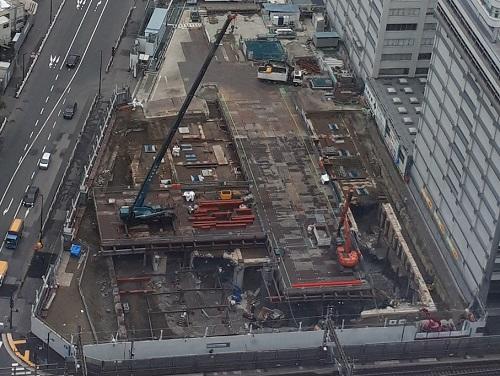
[wienerhorn]
December 6, 2018 12:00
 Matsushima Shrine, one of Nihonbashi Seven Lucky Gods, is located in Nihonbashi Ningyocho, where great power gods are enshrined. According to Monoshiri Encyclopedia in Chuo-ku, "At the time of its foundation, the surrounding area was Kojima in the inlet, and the pine was overgrown in Shimauchi, so it was named." Matsushima Shrine, one of Nihonbashi Seven Lucky Gods, is located in Nihonbashi Ningyocho, where great power gods are enshrined. According to Monoshiri Encyclopedia in Chuo-ku, "At the time of its foundation, the surrounding area was Kojima in the inlet, and the pine was overgrown in Shimauchi, so it was named."
However, the torii gate says "Matsushima Shrine", which is the correct one of "island" or "shima"? I don't think it is.
When I looked for a material using "Shima", I found it! The "Kanpo gu ticket map" created in 1744 (Kanbo 4) is published in the Chuo-ku Board of Education, Tokyo, "Chuo-ku Historical Map (Nihonbashi Edition)" and the place name of "Matsushima-cho" is written. Was.
In terms of origin, it is an "island", but "shima" was sometimes used, so should you understand it?
It's fun to see old maps.
[wienerhorn]
December 5, 2018 14:00
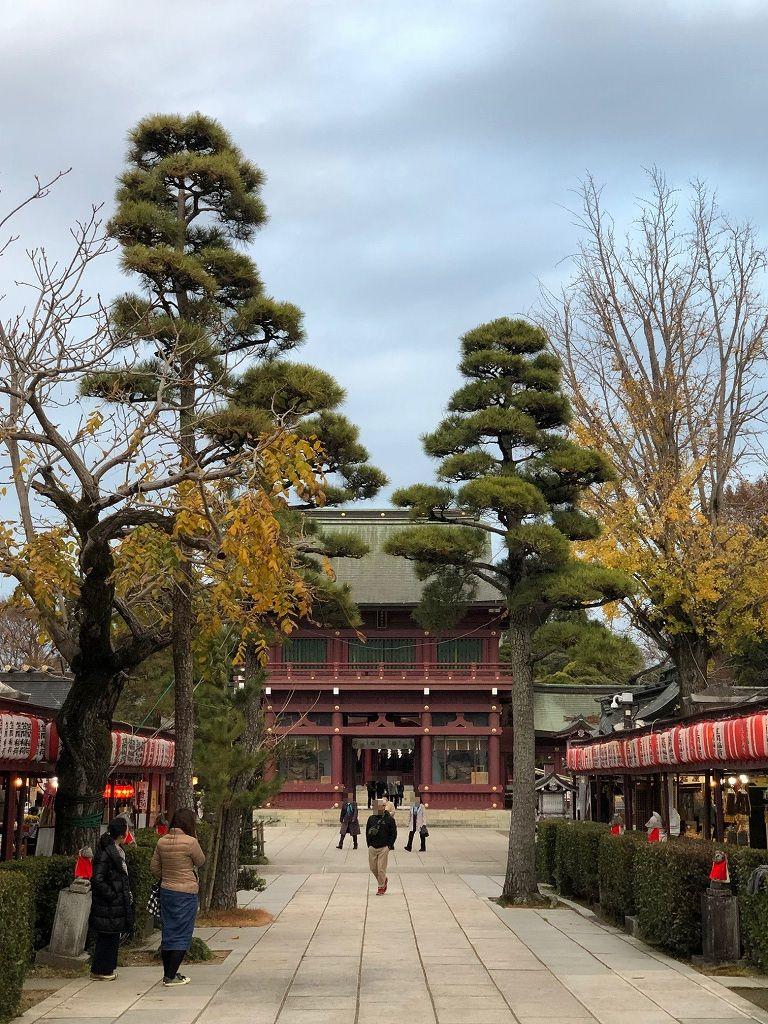
Photo: Kasama Inari Shrine (Kasama City, Ibaraki Prefecture)
Nihonbashi Shichifukujin is located in the vicinity of Tokyo Metro's Suitengumae Station, Ningyocho Station, Kodemmacho Station, and Hamacho Station on the Toei Subway, and if you do your best, you can tour Seven Lucky Gods in an hour. Among them is Kasama Inari Shrine Tokyo Bessha. If you have studied the Chuo-ku Tourism Certification, you know well. It's impressive because it's a long name with 10 characters. It was built at its current location in 1859 in the late Edo period as a branch of Kasama Inari Shrine (Kasama City, Ibaraki Prefecture).
The other day, when I happened to drive in Ibaraki Prefecture, "Kasama Inari Shrine" was displayed on the car navigation system, so this is that! I stopped by in a hurry. It was founded in 651 and is one of the three largest Inari shrines in Japan. It was a very impressive space with a solemn atmosphere, a large shrine, and Nakamise. new year worshipping is coming soon, but many worshiper will come.
[Hanes]
December 4, 2018 12:00
Hello. This is a new correspondent, Hanes. 
More than a month has passed since the reopening of the antenna shop IBARAKI sense in Ibaraki Prefecture, and Ibaraki sense.
Have you gone to a new shop yet?
On the day of the reopening, tape cuts were made by actress Miho Shiraishi and actor Gota Watanabe from Ibaraki Prefecture, and it became a hot topic!
I'm also from Ibaraki Prefecture, so I stopped by with my colleagues on the day of the opening.
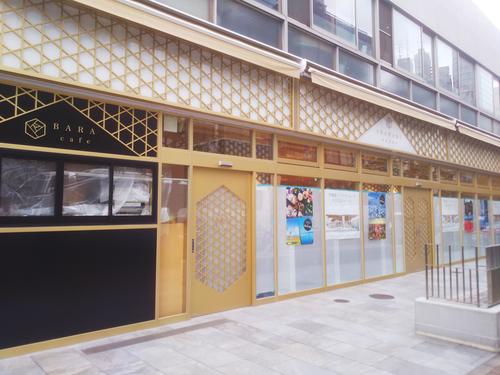
(State of stores under renovation)
It has been reborn as a fashionable space that has a sense of openness than before.
I hope that the impression of Ibaraki Prefecture will be better enough to recover at once in the attractiveness ranking.
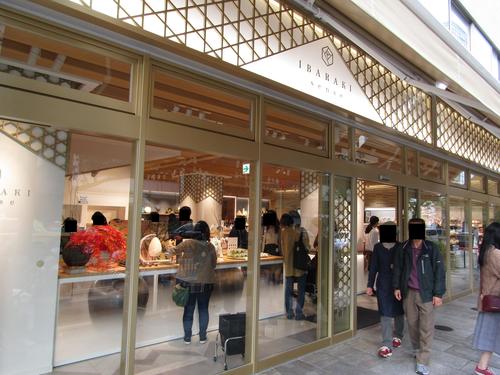
(The state of the store in early November)
Well, what did Hanes buy at an antenna shop in Ibaraki Prefecture?...
■Saza Coffee (Saza Coffee)
The answer is the Saza Coffee of BARA cafe attached to IBARAKI sense.
Some people may think, "Why is coffee?"
Actually, this is a slightly luxurious self-roasted coffee loved by citizens of the prefecture, which has a reputation for being delicious in the prefecture.

This coffee shop was founded in 1969 by the operating company of the movie theater "Katsuta Takarazuka Theater".
In 1997, we opened a directly managed farm in Colombia, South America.
In 2017, we won the first championship at the FNC Colombia Cauca District Fair.
It's also appreciated in coffee beans producing areas, so you can't miss the coffee street!
You can eat only a few kinds in this cafe, but you can enjoy it.
At the Saza Coffee store, there is a "Tokugawa Shogun Coffee" created in collaboration with Yoshitomo Tokugawa, the fourth generation of the Yoshinobu Tokugawa family.
This is where Yoshinobu hired a French chef during the negotiations on the opening of the port in 1867.
We investigated and reproduced the literature at the time of offering hospitality coffee to Western ministers.
It is a modern version of late Tokugawa shogunate's French-style coffee.
Not only coffee lovers, but also history lovers, don't you worry about the flavor?
In this way, Ibaraki Prefecture, which is closely related to Edo and Tokyo due to the connection of the Tokugawa family....
From here, we will introduce spots related to Ibaraki Prefecture in the city every time!
Edo period
■Samurai residence
Samurai residence in Ibaraki Prefecture (part of Hitachi and Shimousa) was relatively large in the ward.
Kamiyashiki: Hitachi Aso Domain Shinjo Sun Komori Naotake (3-chome, Nihonbashihama-cho)
Nakayashiki: Hitachi Kasama Domain Makino Bingo Mamoru Sadanao (around Meijiza)
Shimousa Furukawa Clan Doi Daikanto Toshinori (Nihonbashihakozakicho, around IBM Hakozaki Building)
■Kasama Inari Shrine Tokyo Betsusha
Kasama Inari Shrine Tokyo Betsusha, a company in Nihonbashi Seven Lucky Gods, Nihonbashi located in Nihonbashihamacho.
It was a shrine that was separated from Kasama Inari Shrine in Ibaraki Prefecture, one of Japan's three major Inari shrines in the middle of the Edo period.
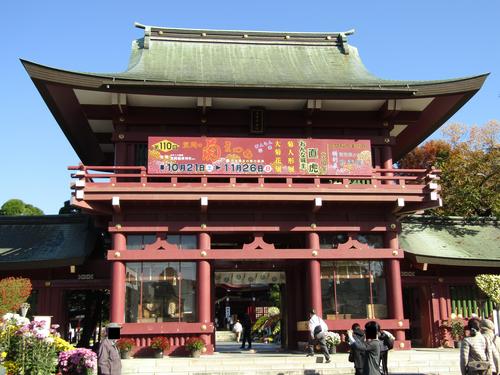
(Kasama Inari Shrine, the head office. Photographed in 2017.
The Chrysanthemum Festival is held every November and is full of many people.
It is relatively easy to access from Tokyo.
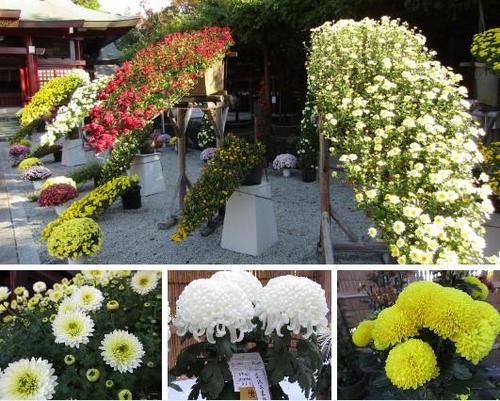
■Ishikawajima Museum
In 1853, when Perry arrived.
The Mito clan Nariaki Tokugawa founded the "Ishikawajima Shipyard" to enhance Japan's military power.
Here, the construction of Japan's first Western-style sailing warship "Xuri Maru" was started, and modern shipbuilding began.
Today, at this museum in Tsukuda, you can learn about the history and culture of Tsukuda Island and shipyards.
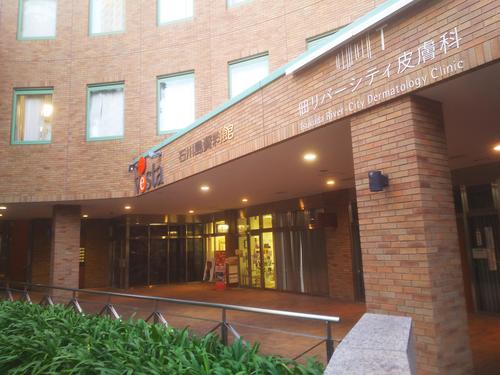
[Meiji period]
■Nihonbashi
Nihonbashi was built for the first time in 1603 and became the center of Japan the following year as the starting point of the Gokaido.
The stone double arch bridge we are currently crossing is completed in 1911.
The bronze sculpture of the kirin and lion, designed by architect Yorinaka Tsumaki, is impressive.
Surprisingly, this bridge also has an Ibaraki element!
More than 40,000 Inada stones cut out from Inada (Kasama City) in Ibaraki Prefecture are used for the pavement and arch.
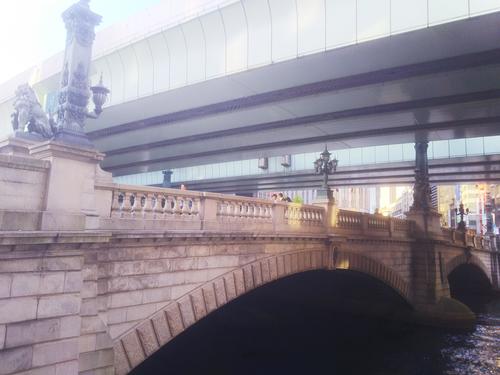
Inada stone, which is said to be the "white granite in Japan", is also used in the Supreme Court and Hibiya Dai-ichi Seimei Building, and has recently been used for cobblestones in the square inside the JR Tokyo Station Maru completed in December last year. It is attracting attention again.
It is also used as a wall of IBARAKI sense.
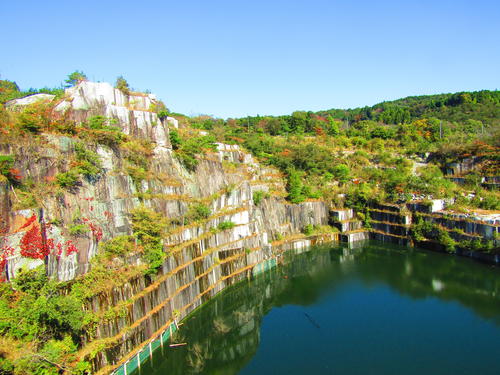
(One of the Inada stone quarrys in Kasama City. Photographed in 2017. It looks great  on Instagram. on Instagram.
◼️ Pharmaceutical ancestor patron
Do you know this shrine right next to the forest of Fukutoku?
As you can imagine from the name of the shrine, it enshrines the pharmaceutical ancestor patron Nikami, and is said to have the benefit of disease-free health and illness healing.
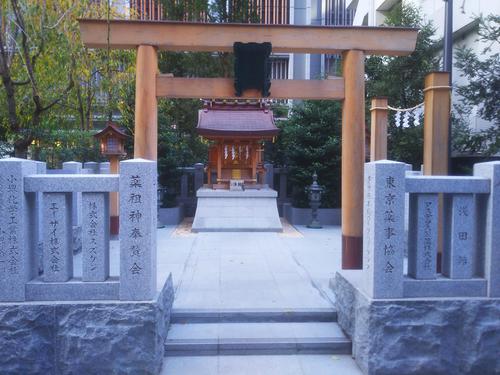
At first glance, it doesn't seem to have anything to do with Ibaraki Prefecture, but in fact, in the medicine industry in Nihonbashi Honmachi, it seems that it has nothing to do with Ibaraki Prefecture.
It is said that he has visited the Oarai Isomae Shrine and the Sakatsurai Sosaki Shrine in Ibaraki Prefecture, whose Nikami is the enshrined deity, and has shown a sense of reverence.
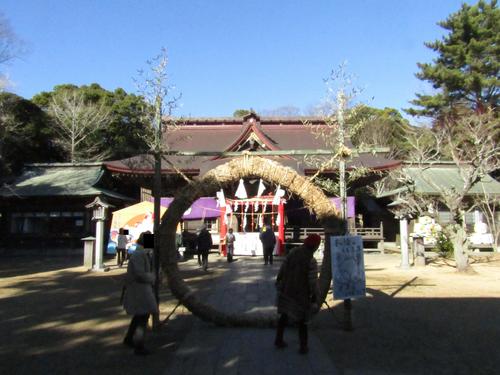
(Oarai Isosaki-jinja Shrine is located at the end of the long stairs. Photographed in 2017.
There is a torii gate of Kamiiso in the sea nearby.
This was also introduced on a poster affixed to the glass during the IBARAKI sense renewal work.
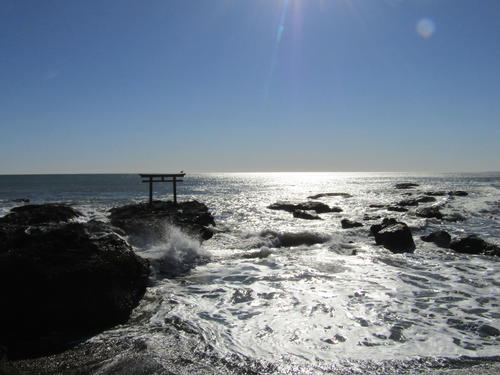
(Shooted in 2017.)
So far, I've introduced some of the Ibaraki elements found in Chuo-ku since the Edo period, how was it?
As typified by Nihonbashi, some people may first know that there is an Ibaraki element in a surprisingly familiar and familiar place.
There are many charms of Ibaraki Prefecture just because it is not known yet!
While walking around the city in Chuo-ku, be sure to find a shining spot of IBARAKI sense.
■IBARAKI sense
Address: Konya Building 1F, 1-2-1 Ginza, Chuo-ku, Tokyo
Business hours Shop Café 10:30-20:00
Restaurant 11:00-23:00 (21:00 on Sundays and holidays)
Official Website: https://ibaraki-sense.com/
※This article has been approved by the manager of IBARAKI sense.
[References]
Ministry of Land, Infrastructure, Transport and Tourism Kanto Regional Development Bureau Tokyo National Land Office “Nihonbashi decorations” http://www.ktr.mlit.go.jp/toukoku/panf/nihonbashi100/pdf/rekishi-03-04.pdf
Kota Kodama (supervised) "Restore / Edo Information Map" (Asahi Shimbun, 1994).
|
Links
|
 Kiyosu Bridge, a nationally designated important cultural property, is one of the reconstruction bridges after the Great Kanto Earthquake, and is famous as one of the beautiful bridges that span the Sumida River along with Eitai Bridge.
Kiyosu Bridge, a nationally designated important cultural property, is one of the reconstruction bridges after the Great Kanto Earthquake, and is famous as one of the beautiful bridges that span the Sumida River along with Eitai Bridge.









 (Slightly expand construction sites only ↓)
(Slightly expand construction sites only ↓)
 Matsushima Shrine, one of Nihonbashi Seven Lucky Gods, is located in Nihonbashi Ningyocho, where great power gods are enshrined. According to Monoshiri Encyclopedia in Chuo-ku, "At the time of its foundation, the surrounding area was Kojima in the inlet, and the pine was overgrown in Shimauchi, so it was named."
Matsushima Shrine, one of Nihonbashi Seven Lucky Gods, is located in Nihonbashi Ningyocho, where great power gods are enshrined. According to Monoshiri Encyclopedia in Chuo-ku, "At the time of its foundation, the surrounding area was Kojima in the inlet, and the pine was overgrown in Shimauchi, so it was named."












